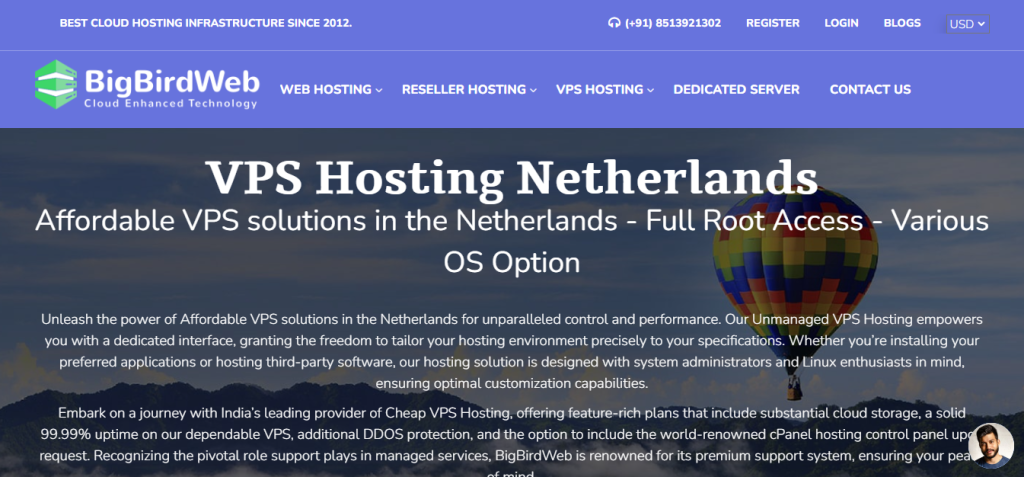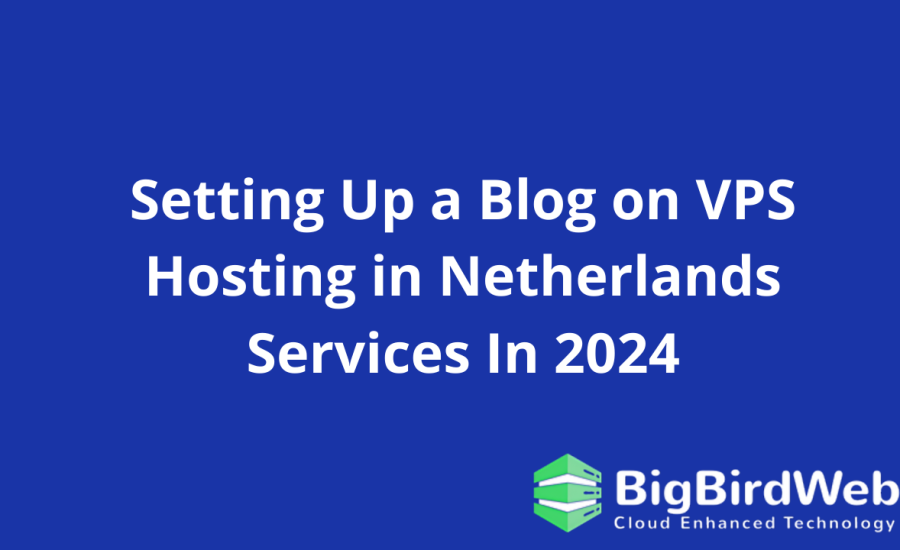Setting up a blog on VPS Hosting in Netherlands Services can be a game-changer for your online presence. VPS (Virtual Private Server) hosting offers a level of control, performance, and reliability that shared hosting simply cannot match. If you’re looking to start a blog with VPS Hosting in Netherlands Services, this guide will walk you through the essential steps to get your blog up and running smoothly.

Table of Contents
Why Choose VPS Hosting in Netherlands Services?

When selecting a hosting provider, VPS Hosting in Netherlands Services offers several advantages:
- Performance: Unlike shared hosting, a VPS provides dedicated resources, which means your blog will load faster and handle traffic better.
- Control: You have root access to your server, allowing for greater customization and control over your hosting environment.
- Security: VPS Hosting in Netherlands Services offers enhanced security features compared to shared hosting, helping to protect your blog from potential threats.
These benefits make VPS Hosting in Netherlands Services an ideal choice for those who want to build a reliable and high-performing blog.
Step-by-Step Guide to Setting Up Your Blog on VPS Hosting in Netherlands Services

1. Choose Your VPS Hosting in Netherlands Services Provider
The first step in setting up a blog is selecting a reliable VPS Hosting in Netherlands Services provider. Look for providers that offer:
- Performance: Ensure they provide high uptime guarantees and fast servers. You can also opt for free web hosting.
- Support: Opt for providers with good customer support to help with any issues.
- Scalability: Choose a provider that allows you to easily upgrade your server resources as your blog grows.
Once you’ve chosen a provider, sign up for a VPS plan that meets your needs.
2. Access Your VPS Server
After purchasing a VPS Hosting in Netherlands Services plan, you will receive login credentials for your server. To access your VPS:
- Use SSH (Secure Shell): For Linux-based servers, you can use an SSH client like PuTTY to connect to your server.
- Remote Desktop: For Windows-based servers, use Remote Desktop Protocol (RDP) to access your VPS.
Make sure to change your default passwords and set up strong security measures to protect your server.
3. Install a Web Server
Your VPS needs a web server to host your blog. Common choices include:
- Apache: A popular open-source web server known for its flexibility and power.
- Nginx: Known for its high performance and low resource consumption.
To install a web server:
- For Apache: Use package managers like
apt-getoryumto install Apache. For example, on a Debian-based system, you would usesudo apt-get install apache2. - For Nginx: Similarly, install Nginx using
sudo apt-get install nginx.
4. Set Up a Database Server
Most blogs require a database to store content and settings. VPS Hosting in Netherlands Services allows you to install and configure a database server like:
- MySQL: A widely used open-source database.
- MariaDB: A fork of MySQL with additional features.
To install MySQL or MariaDB:
- For MySQL: Run
sudo apt-get install mysql-serveron a Debian-based system. - For MariaDB: Use
sudo apt-get install mariadb-server.
Follow the setup instructions to configure your database server and secure it.
5. Install PHP
PHP is a scripting language often used for dynamic content in blogs. To install PHP on your VPS Hosting in Netherlands Services:
- For Debian-based systems: Run
sudo apt-get install php php-mysqlto install PHP along with the MySQL module. - For Red Hat-based systems: Use
sudo yum install php php-mysql.
Make sure PHP is configured to work with your web server (Apache or Nginx).
6. Choose a Blogging Platform
There are several blogging platforms available, but WordPress is the most popular due to its ease of use and flexibility. To install WordPress:
- Download WordPress: Get the latest version from the official website.
- Upload WordPress: Upload the WordPress files to your web server’s root directory, usually located in
/var/www/html/for Apache or/usr/share/nginx/html/for Nginx. - Create a Database: Log into your database server and create a new database and user for WordPress.
- Configure WordPress: Open your web browser and navigate to your server’s IP address. Follow the on-screen instructions to complete the WordPress installation.
7. Configure Domain and SSL
To make your blog accessible through a domain name and ensure security:
- Register a Domain: Purchase a domain name from a registrar and point it to your VPS server’s IP address.
- Install SSL Certificate: Use tools like Let’s Encrypt to obtain a free SSL certificate. Install it on your server to enable HTTPS for your blog.
Configuring your domain and SSL certificate ensures that your blog is secure and accessible to users.
8. Optimize Your Blog for SEO
With your blog set up on VPS Hosting in Netherlands Services, it’s time to focus on SEO to increase visibility:
- Choose an SEO-Friendly Theme: Select a WordPress theme optimized for SEO.
- Install SEO Plugins: Use plugins like Yoast SEO to manage and improve your blog’s SEO.
- Create Quality Content: Regularly publish high-quality, relevant content that appeals to your target audience.
Optimizing your blog for SEO helps attract more visitors and improves your search engine rankings.
9. Implement Security Measures
Protecting your blog is crucial to ensure its longevity and reliability. Implement security measures such as:
- Regular Backups: Schedule automated backups of your blog and database to prevent data loss.
- Firewall: Set up a firewall to block unauthorized access to your server.
- Updates: Regularly update your server software, WordPress, and plugins to patch security vulnerabilities.
Securing your blog protects it from potential threats and ensures a stable user experience.
10. Monitor and Maintain Your Blog
Ongoing monitoring and maintenance are essential for keeping your blog in top shape:
- Performance Monitoring: Use tools like Google Analytics to track your blog’s performance and visitor behavior.
- Regular Maintenance: Perform routine maintenance tasks such as clearing cache, checking for broken links, and optimizing database tables.
Regular monitoring and maintenance ensure that your blog remains functional and efficient.
Conclusion
Setting up a blog on VPS Hosting in Netherlands Services provides you with enhanced control, performance, and security. By following the steps outlined in this guide—from choosing a provider and installing necessary software to configuring your domain and implementing security measures—you can successfully launch and manage a high-performing blog. With the right setup and optimization, your blog can achieve better visibility and provide a great user experience.
FAQs
Q1: What is the advantage of using *VPS Hosting in Netherlands Services* for my blog?**
A1: VPS Hosting in Netherlands Services offers better performance, control, and security compared to shared hosting. It provides dedicated resources, allowing your blog to load faster and handle traffic more efficiently.
Q2: How do I choose the right VPS Hosting in Netherlands Services provider?
A2: Look for a provider with high uptime guarantees, good customer support, and scalability options. Ensure they offer reliable performance and meet your specific needs.
Q3: What are the essential steps to install WordPress on VPS Hosting in Netherlands Services?
A3: The essential steps include downloading WordPress, uploading it to your server, creating a database, configuring WordPress, and completing the installation through your web browser.
Q4: How can I improve my blog’s SEO on VPS Hosting in Netherlands Services?
A4: Improve your blog’s SEO by choosing an SEO-friendly theme, installing SEO plugins, and creating high-quality content. Optimize your blog’s performance and ensure it is accessible and secure.
Q5: What security measures should I implement for my blog on VPS Hosting in Netherlands Services?
A5: Implement security measures such as regular backups, a firewall, and keeping your server software and WordPress up to date. These steps help protect your blog from threats and vulnerabilities.
Bonus Content: Advanced Tips for Optimizing Your Blog on VPS Hosting in Netherlands Services
1. Leverage Server-Side Caching
Server-side caching can greatly enhance your blog’s performance. Tools like Varnish or Redis can cache dynamic content and reduce server load, resulting in faster page load times.
Setting Up Caching:
- Install Caching Software: Use package managers to install caching software on your VPS.
- Configure Caching Rules: Set up caching rules to determine which content should be cached.
- Monitor Performance: Regularly review caching performance to ensure it’s working effectively.
By leveraging server-side caching, you can significantly boost your blog’s speed and efficiency.
2. Use a Content Delivery Network (CDN)
A CDN can help distribute your blog’s content globally, reducing latency and improving load times for visitors regardless of their location.
Integrating a CDN:
- Choose a CDN Provider: Select a reputable CDN provider that offers integration with VPS Hosting in Netherlands Services.
- Configure CDN Settings: Set up your CDN to cache and deliver static assets like images and scripts.
- Monitor CDN Performance: Track the performance of your CDN to ensure it’s delivering content efficiently.
Advanced Tips for Optimizing Your Blog on VPS Hosting in Netherlands Services
1. Leverage Server-Side Caching
Server-side caching can significantly enhance your blog’s performance. By storing frequently accessed data in the server’s memory, caching reduces the time it takes to deliver content to users. This is especially important when using VPS Hosting in Netherlands Services to ensure your blog runs smoothly even under high traffic conditions.
Setting Up Caching:
- Install Caching Software: Use package managers like
apt-getoryumto install caching software such as Varnish or Redis on your VPS. - Configure Caching Rules: Determine which content should be cached. Typically, static content like images, CSS, and JavaScript files are cached, while dynamic content is generated on the fly.
- Monitor Performance: Regularly review your caching performance using monitoring tools. This helps ensure that the cache is effectively reducing load times and improving user experience.
By leveraging server-side caching, you can significantly boost your blog’s speed and efficiency on VPS Hosting in Netherlands Services.
2. Use a Content Delivery Network (CDN)
A Content Delivery Network (CDN) can help distribute your blog’s content globally, reducing latency and improving load times for visitors regardless of their location. When combined with VPS Hosting in Netherlands Services, a CDN can enhance your blog’s performance and reliability.
Integrating a CDN:
- Choose a CDN Provider: Select a reputable CDN provider that offers integration with VPS Hosting in Netherlands Services.
- Configure CDN Settings: Set up your CDN to cache and deliver static assets like images, scripts, and stylesheets.
- Monitor CDN Performance: Use analytics and monitoring tools to track the performance of your CDN. Ensure it’s effectively delivering content and reducing server load.
Utilizing a CDN can significantly improve your blog’s performance by ensuring faster delivery of content to users worldwide.
3. Optimize Database Performance
Efficient database management is crucial for the smooth operation of your blog. VPS Hosting in Netherlands Services provides the resources needed to optimize your database for better performance.
Database Optimization Tips:
- Regular Maintenance: Perform routine maintenance tasks like optimizing tables, checking for errors, and cleaning up unused data.
- Indexing: Ensure that your database tables are properly indexed to speed up query performance.
- Caching Database Queries: Use query caching to store the results of frequently run queries, reducing the load on your database server.
By optimizing your database, you can improve your blog’s speed and responsiveness, providing a better experience for your visitors.
4. Implement Advanced Security Measures
Security is a top priority for any blog, and VPS Hosting in Netherlands Services provides the tools needed to implement advanced security measures.
Security Enhancements:
- Firewall Configuration: Set up a firewall to block unauthorized access to your VPS.
- Intrusion Detection Systems (IDS): Implement IDS to monitor and detect potential security threats.
- Regular Security Audits: Conduct regular security audits to identify and fix vulnerabilities in your server and blog.
By enhancing your blog’s security, you protect it from threats and ensure a safe browsing experience for your users.
5. Optimize for Mobile Users
With a growing number of users accessing blogs via mobile devices, optimizing your blog for mobile is essential. VPS Hosting in Netherlands Services allows you to implement these optimizations effectively.
Mobile Optimization Strategies:
- Responsive Design: Ensure your blog uses a responsive design that adapts to various screen sizes.
- Mobile-Friendly Content: Optimize your content for mobile users by using larger fonts, touch-friendly buttons, and streamlined navigation.
- Accelerated Mobile Pages (AMP): Implement AMP to provide a faster, smoother experience for mobile users.
Optimizing your blog for mobile ensures that it caters to a wider audience, improving user satisfaction and SEO performance.
6. Monitor and Analyze Performance
Continuous monitoring and analysis are crucial for maintaining and improving your blog’s performance. VPS Hosting in Netherlands Services provides the tools and resources needed for effective performance monitoring.
Performance Monitoring Tools:
- Google Analytics: Track user behavior, traffic sources, and other key metrics to understand how visitors interact with your blog.
- Server Monitoring Tools: Use tools like Nagios or Monit to monitor server performance, resource usage, and uptime.
- Error Logs: Regularly check your server’s error logs to identify and fix issues that could affect your blog’s performance.
By monitoring and analyzing performance, you can make data-driven decisions to enhance your blog and provide a better experience for your visitors.
7. Implement SEO Best Practices
Search Engine Optimization (SEO) is essential for increasing your blog’s visibility and attracting more visitors. VPS Hosting in Netherlands Services allows you to implement SEO best practices effectively.
SEO Strategies:
- Keyword Optimization: Research and use relevant keywords in your content, titles, and meta descriptions.
- Quality Content: Create high-quality, valuable content that addresses the needs and interests of your target audience.
- Link Building: Build a strong backlink profile by acquiring links from reputable websites.
Implementing these SEO best practices helps improve your blog’s search engine rankings and drive more organic traffic.
8. Leverage Social Media
Social media can be a powerful tool for promoting your blog and engaging with your audience. When combined with VPS Hosting in Netherlands Services, social media integration can enhance your blog’s reach and impact.
Social Media Strategies:
- Share Content: Regularly share your blog posts on social media platforms to reach a wider audience.
- Engage with Followers: Respond to comments, questions, and feedback from your followers to build a loyal community.
- Use Social Media Plugins: Integrate social media sharing buttons on your blog to make it easy for visitors to share your content.
Leveraging social media helps increase your blog’s visibility, drive traffic, and build a strong online presence.
9. Implement Backup Solutions
Regular backups are crucial to ensure the safety and integrity of your blog’s data. VPS Hosting in Netherlands Services allows you to set up and manage robust backup solutions.
Backup Strategies:
- Automated Backups: Set up automated backups to regularly save copies of your blog’s files and database.
- Offsite Storage: Store backups offsite to protect against data loss due to server failures or other issues.
- Regular Testing: Periodically test your backups to ensure they can be successfully restored.
Implementing reliable backup solutions helps protect your blog from data loss and ensures continuity in case of unexpected issues.
10. Enhance User Experience (UX)
Providing a great user experience is key to retaining visitors and encouraging them to return to your blog. VPS Hosting in Netherlands Services offers the performance and flexibility needed to enhance UX.
User Experience Enhancements:
- Fast Load Times: Optimize your blog’s speed by minimizing resource-heavy elements and using caching.
- Intuitive Navigation: Design a clear and easy-to-navigate layout to help visitors find what they’re looking for.
- Engaging Content: Create compelling content that keeps visitors engaged and encourages them to explore more of your blog.
By focusing on UX, you can create a blog that visitors enjoy and want to return to, ultimately improving your blog’s success.
Conclusion
Optimizing your blog on VPS Hosting in Netherlands Services involves implementing a range of advanced strategies, from leveraging server-side caching and using a CDN to enhancing security and optimizing for mobile users. By following these tips, you can ensure your blog runs smoothly, provides a great user experience, and ranks well in search engine results. Regular monitoring, performance analysis, and adherence to SEO best practices will help you continuously improve your blog and achieve long-term success.
Bonus FAQs
Q6: How do I choose the best SEO plugins for my blog on VPS Hosting in Netherlands Services?
A6: Look for SEO plugins that offer comprehensive features, such as keyword optimization, content analysis, and XML sitemap generation. Popular choices include Yoast SEO and All in One SEO Pack.
Q7: Can I migrate my existing blog to VPS Hosting in Netherlands Services?
A7: Yes, you can migrate your existing blog to VPS Hosting in Netherlands Services. Most hosting providers offer migration services or guides to help you transfer your blog’s files, database, and settings.
Q8: How often should I back up my blog on VPS Hosting in Netherlands Services?
A8: It’s recommended to perform daily backups of your blog’s files and database. Automated backup solutions can help ensure your data is regularly saved without manual intervention.
Q9: What are some common security plugins for WordPress blogs on VPS Hosting in Netherlands Services?
A9: Common security plugins include Wordfence, Sucuri Security, and iThemes Security. These plugins offer features like malware scanning, firewall protection, and login security to keep your blog safe.
Q10: How can I improve the loading speed of my blog on VPS Hosting in Netherlands Services?
A10: Improve your blog’s loading speed by optimizing images, using caching solutions, leveraging a CDN, and minimizing the use of heavy scripts and plugins. Regularly monitor and optimize your server performance to ensure fast load times.
